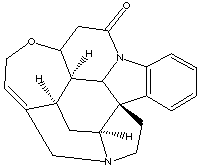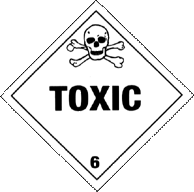Strychnine
- Strychnidin-10-one
- Nux vomica
- Strynchnos

Strychnine | |
| |
| Formula | C21H22N2O2 |
| Structure |  |
| Description | Colorless crystals. |
| Uses | Chiefly in poison baits for rodents. Also used as avicide. |
| Registry Numbers and Inventories. | |
| CAS | 57-24-9 |
| EC (EINECS/ELINCS) | 200-319-7 |
| EC Index Number | 614-003-00-5 |
| EC Class | Very toxic; Dangerous for the Environment |
| RTECS | WL2275000 |
| RTECS class | Agricultural Chemical and Pesticide; Drug; Reproductive Effector; Human Data |
| UN (DOT) | 1692 |
| Merck | 12,9020 |
| Beilstein/Gmelin | 52979 |
| Beilstein Reference | 4-27-00-07537 |
| RCRA | P108 |
| EPA OPP | 76901 |
| Swiss Giftliste 1 | G-2895 |
| Canada DSL/NDSL | DSL |
| US TSCA | Listed |
| Austrailia AICS | Listed |
| New Zealand | Listed |
| Properties. | |
| Formula | C21H22N2O2 |
| Formula mass | 334.42 |
| Melting point, °C | 268 |
| Boiling point, °C | 560 |
| Vapor pressure, mmHg | 1E-14 (25 C) |
| Vapor density (air=1) | 11.0 |
| Density | 1.36 g/cm3 (20 C) |
| Solubility in water | 140 mg/L |
| pKa/pKb | 5.74 (pKb) |
| Partition coefficient, pKow | 1.93 |
| Heat of vaporization | 84.2 kJ/mol |
| Hazards and Protection. | |
| Storage | Store in a tightly closed container. Store in a cool, dry, well-ventilated area away from incompatible substances. Poison room locked. |
| Handling | Wash thoroughly after handling. Wash hands before eating. Use with adequate ventilation. Minimize dust generation and accumulation. Avoid contact with eyes, skin, and clothing. Keep container tightly closed. Avoid ingestion and inhalation. Use only in a chemical fume hood. Wash clothing before reuse. |
| Protection | Eyes: Wear appropriate protective eyeglasses or chemical safety goggles as described by OSHA's eye and face protection regulations in 29 CFR 1910.133 or European Standard EN166. Skin: Wear butyl rubber gloves to prevent skin exposure. Clothing: Wear appropriate protective clothing to prevent skin exposure. |
| Respirators | Follow the OSHA respirator regulations found in 29CFR 1910.134 or European Standard EN 149. Always use a NIOSH or European Standard EN 149 approved respirator when necessary. |
| Small spills/leaks | Vacuum or sweep up material and place into a suitable disposal container. Avoid runoff into storm sewers and ditches which lead to waterways. Clean up spills immediately, using the appropriate protective equipment. Avoid generating dusty conditions. Provide ventilation. |
| Stability | Stable at room temperature in closed containers under normal storage and handling conditions. |
| Incompatibilities | Strong oxidizing agents, alkali hydroxides, bromides, carbonates, iodides. |
| Decomposition | Nitrogen oxides, carbon monoxide, irritating and toxic fumes and gases, carbon dioxide, sulfur oxides (SOx), including sulfur oxide and sulfur dioxide. |
| Fire. | ||||
| Flash Point,°C | 292 | |||
| Fire fighting | Wear a self-contained breathing apparatus in pressure-demand, MSHA/NIOSH (approved or equivalent), and full protective gear. During a fire, irritating and highly toxic gases may be generated by thermal decomposition or combustion. Use water spray to keep fire-exposed containers cool. Use extinguishing media appropriate to the surrounding fire. Substance is noncombustible. Extinguishing media: Substance is noncombustible; use agent most appropriate to extinguish surrounding fire. Do NOT use straight streams of water. For small fires, use dry chemical, carbon dioxide, or water spray. For large fires, use water spray, fog or regular foam. Cool containers with flooding quantities of water until well after fire is out. | |||
| Fire potential | Non-Combustible | |||
| Hazards | When heated, emits highly toxic fumes. Runoff from fire control or dilution water may cause pollution. Protect from light. | |||
| Combustion products | Toxic oxides of nitrogen are produced during combustion of this material. | |||
| NFPA | Health | 4 | ||
| Flammability | 0 | |||
| Reactivity | 0 | |||
| Health. | |
| Exposure limit(s) | TLV: ppm; 0.15 mg/m3 (as TWA) (ACGIH 1992-1993). OSHA PEL: TWA 0.15 mg/m3 NIOSH REL: TWA 0.15 mg/m3 NIOSH IDLH: 3 mg/m3 |
| Poison_Class | 1 |
| Exposure effects | May cause cyanosis, acidosis, and quick, shallow breathing. |
| Ingestion | May be fatal if swallowed. May cause irritation of the digestive tract. May cause liver and kidney damage. May cause central nervous system effects and/or neurological effects. Effects may be delayed. May cause convulsions, increased blood pressure, muscle spasms, and possible paralysis. |
| Inhalation | Effects may be delayed. May cause respiratory tract irritation. Inhalation may lead to hematemesis, convulsions, shock, coma, and possible death. |
| Skin | May cause skin irritation. Absorption into the body may cause cyanosis. |
| Eyes | May cause eye irritation. |
First aid |
|
| Ingestion | Never give anything by mouth to an unconscious person. Get medical aid immediately. Induce vomiting by giving one teaspoon of Syrup of Ipecac. SPEED IS ESSENTIAL. A DOCTOR MUST BE NOTIFIED AT ONCE. Call a poison control center. |
| Inhalation | Remove from exposure to fresh air immediately. If not breathing, give artificial respiration. If breathing is difficult, give oxygen. DO NOT use mouth-to-mouth respiration. SPEED IS ESSENTIAL, OBTAIN MEDICAL AID IMMEDIATELY. |
| Skin | Get medical aid. Flush skin with plenty of soap and water for at least 15 minutes while removing contaminated clothing and shoes. Wash clothing before reuse. |
| Eyes | Flush eyes with plenty of water for at least 15 minutes, occasionally lifting the upper and lower eyelids. Get medical aid. |
| Transport. | ||
| UN number | 1692 |  |
| Response guide | 151 | |
| Hazard class | 6.1 | |
| Packing Group | I | |
| USCG CHRIS Code | STR | |